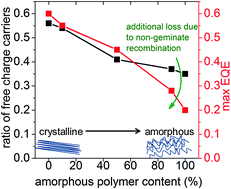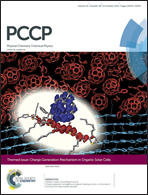Control of charge generation and recombination in ternary polymer/polymer:fullerene photovoltaic blends using amorphous and semi-crystalline copolymers as donors†
Abstract
Charge generation and recombination processes occurring in ternary photoactive copolymer:copolymer:fullerene blends consisting of different mixing ratios between entirely amorphous and semi-crystalline PPE-PPV copolymers are investigated by transient absorption pump–probe and pump–push photocurrent spectroscopy. The experiments reveal that an excess of semi-crystalline polymer facilitates exciton dissociation into free charge carriers, slows down geminate recombination, and suppresses non-geminate recombination leading to increased short-circuit currents and high fill factors. In contrast, blends utilizing solely the amorphous polymer for their donor phase suffer from a large fraction of sub-nanosecond geminate recombination of interfacially bound charge-transfer states and also from fast non-geminate recombination of free charges, resulting in a significantly reduced photovoltaic performance. However, small fractions of the amorphous polymer blended into the semi-crystalline polymer increase the open-circuit voltage and the fill factor, while keeping the charge generation and recombination parameters largely unaltered in turn leading to an optimized device performance for the ternary PPE-PPV copolymer:copolymer:fullerene blends.

- This article is part of the themed collection: Charge Generation Mechanism in Organic Solar Cells

 Please wait while we load your content...
Please wait while we load your content...